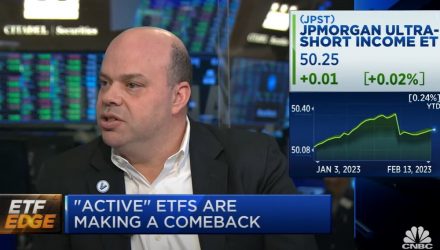VettaFi director of research Todd Rosenbluth appeared with PIMCO’s Jerome Schneider and JP Morgan’s James McNerny, on ETF Edge with CNBC’s Michael Santoli filling in as host for Bob Pisani. The panel discussed the Fed’s potential to achieve a soft landing, recession risk, and actively managed strategies.
Fixated on Fixed Income
Discussing whether or not the Fed can achieve a soft landing and how investors can best prepare themselves, Rosenbluth noted that investors are flocking to bonds, with bond ETFs achieving $20 billion in inflows in January alone, “there’s now income in fixed income.” Rosenbluth sees investors as taking a measured approach to the environment, with money moving both to safer products like the JPMorgan Ultra-Short Income ETF (JPST) and higher yield products like iShares iBoxx $ High Yield Corporate Bond ETF (HYG).
This barbell approach with some risk on and some risk off sentiment could benefit investors. “People were going to equity ETFs for the dividend orientation, now you can get income in fixed income ETFs,” Rosenbluth added. McNerny concurred, noting that fixed income has started to find its stride.
Active Management’s Time to Shine
Pointing to active management’s growing role in the fixed income space, Rosenbluth complimented his fellow guests for demonstrating how active managers can make tactical decisions through fixed income that can mitigate risk and take advantage of opportunities in a way that passive funds can’t. Discussing how uncertain investors are, Rosenbluth noted that, “we’ve got a market that’s been volatile in both 2022 and 2023.”
In addition to market uncertainty, a host of new products have arrived on the scene, creating more options for investors as well as an opportunity for active managers to find the right, specific tool for the job.
Articulating why the ETF structure makes sense for active fixed income ETFs, Rosenbluth noted how active ETFs are cheaper than their mutual funds’ counterparts. “The liquidity is stronger,” he added. Even though investors are buying bonds, ETFs allow them to have a “stock-like” experience on an exchange.
Schneider said, “what the active approach ultimately does is allow you to discern between those attributes where you have visibility and you like risk and those where you don’t.” With more clarity from corporate earnings and the Fed on the horizon, active managers will have the opportunity to adapt and adjust their approaches as unknowns become more known.
For more news, information, and analysis, visit the Active ETF Channel.








